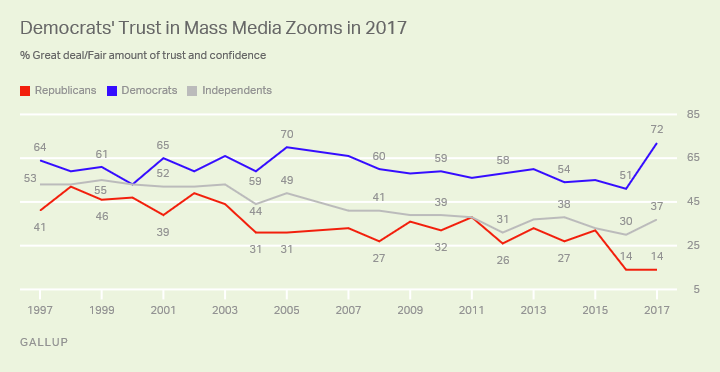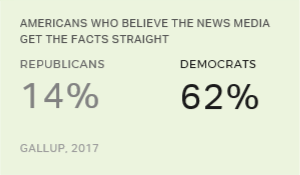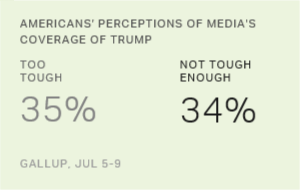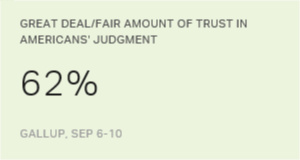Story Highlights
- 72% of Democrats have a "great deal" or "fair amount" of trust in mass media
- Trust and confidence in mass media among all U.S. adults is up to 41%
WASHINGTON, D.C. -- Democrats' trust and confidence in the mass media to report the news "fully, accurately and fairly" has jumped from 51% in 2016 to 72% this year -- fueling a rise in Americans' overall confidence to 41%. Independents' trust has risen modestly to 37%, while Republicans' trust is unchanged at 14%.

Democratic trust and confidence in the news media is the highest it has been in the past 20 years, having previously peaked at 70% in 2005. Following that high, Democrats' trust in the media declined, reaching the lower 50s by 2014.
Democrats' renewed trust in the media may be driven by the perception that it acts as a watchdog over Republican President Donald Trump. Major reporting on the alleged unrest surrounding Trump's administration -- including the departure of several high-level aides and the ongoing investigation into the Trump campaign's potential meddling with Russia -- may be feeding this perception.
Democratic trust has been higher than that of Republicans throughout the past two decades. The only time that Republicans' confidence has topped 50% was in 1998, when 52% expressed trust and confidence in the mass media in the midst of President Bill Clinton's scandal regarding Monica Lewinsky. The 14% trust among Republicans today ties with 2016 as the low for this party in Gallup's trend. The gap in trust between the two parties has reached a record-high 58 percentage points.
Independents' level of trust in the media generally falls between that of Republicans and Democrats. Despite a slight increase this year, the 37% of independents who trust the media is on the lower end of what Gallup has measured for this group. By comparison, before 2003, half or more of independents trusted the media.
The most recent findings, from a Gallup poll conducted Sept. 6-10, dovetail with an August survey showing that 62% of Democrats vs. 14% of Republicans say the media "get the facts straight." The September results also follow a June poll that showed a rising percentage of Americans have a great deal of confidence in newspapers, mostly because of an increase among Democrats.

Gallup Analytics
Subscribe to our online platform and access nearly a century of primary data.
Democratic Surge in Trust Leads to Overall National Uptick
The surge in media trust among Democrats has led to a nine-point increase in the overall percentage of U.S. adults who trust the media compared with last year's record low. Gallup began asking this question in 1972, and has done so nearly every year since 1997. Americans' trust in the mass media peaked in 1976, at 72%, following the investigative journalism of the Watergate scandal and reporting on the Vietnam War. Trust dipped into the 50s in the late 1990s before falling into the 40s during the mid-2000s and beyond.

Bottom Line
Americans' trust in the news media has changed as the nature of media has evolved over the past two decades. The advent of 24-hour news and the internet may have brought more information and analysis to Americans, but it coincides with a general decline in trust overall.
Much of this decline in the past 20 years can be attributed to dampened trust among Republicans and independents. There has been an intensification of cries of "fake news," especially among those on the right wing, claiming the mass media is biased or outright making up news. This has been promulgated by Trump, who has vowed to "continue to attack the press."
Democrats, who in the past 20 years have had greater confidence than Republicans in the media, have sharply higher confidence in the Fourth Estate this year. With major outlets such as The Washington Post and The New York Times conducting in-depth investigations of Trump's presidential campaign and White House officials, Democrats may be heartened by major media outlets seemingly committed to "real" journalism. Yet with Republicans having expressed the most confidence during the Lewinsky scandal, it may be that both parties trust the media when it's targeting a president of the opposite party.
It is also possible that the low point for public trust in the media in 2016 was an anomaly because of the contentious presidential election. Americans may have been frustrated with the media ostensibly paying more attention to Trump or challenger Hillary Clinton.
In the years to come, if Trump continues his assault on the media, the party dynamics seen this year will likely continue for some time.
Survey Methods
Results for this Gallup poll are based on telephone interviews conducted Sept. 6-10, 2017, with a random sample of 1,022 adults, aged 18 and older, living in all 50 U.S. states and the District of Columbia. For results based on the total sample of national adults, the margin of sampling error is ±4 percentage points at the 95% confidence level. All reported margins of sampling error include computed design effects for weighting.
Each sample of national adults includes a minimum quota of 70% cellphone respondents and 30% landline respondents, with additional minimum quotas by time zone within region. Landline and cellular telephone numbers are selected using random-digit-dial methods.
View survey methodology, complete question responses and trends.
Learn more about how the Gallup Poll Social Series works.




